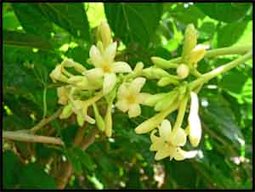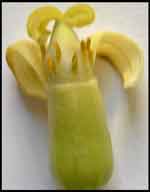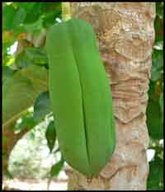
Sexing Pawpaws:
what have I
got in the backyard?
Domestic
and
commercial
pawpaw growers world-wide almost universally use seedlings for pawpaw
propagation, mainly because seed supply is plentiful and cheap,
germination is easy and the juvenility period is so short - 9 months
under ideal conditions. But with seedlings you have to wait till
flowering time to know which of the three main gender types a given
plant will be ie male (staminate), hermaphrodite (bisexual) or female
(pistillate). Modern genetic techniques can answer this question much
sooner, but without research lab facilities the rest of us have to wait
for events to unfold. The dioecious types perform better in
sub-tropical climates like ours, and only one male is required to
pollinate several females; fruit can be formed without pollination
(parthenocarpy) but quality is compromised. So given you’ve probably
sourced your seed from open-pollinated dioecious or self-pollinating
hermaphrodite plants, what proportion of each gender have you grown up
and which ones are either in excess or unwanted and can be culled?
Obviously the sooner you’re able to answer this question following
flowering and then continue with only the desired types, the better.
First you should read the companion article in this series, 'The
mysterious antics of pawpaws', to allow some understanding of
the
markedly variable behaviour and sexual properties of the species. Then
when you have some feel for what you’re dealing with, the intention of
this article is to move on to practical identification of the various
types. Of the three main genders, hermaphrodites show the greatest
variation in features, and their behaviour is also the most influenced
by cultural and environmental factors.
Check
out the following features:
1. Peduncle
length
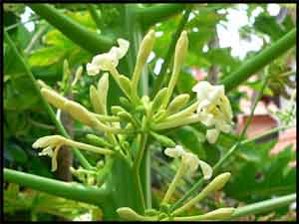 |
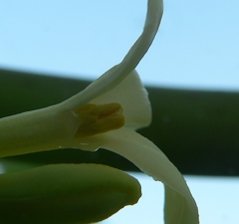 |
Left:
Male inflorescence; Right: Male flower minus petals showing 2 whorls of
different
length alternating stamens. |
For
female and hermaphrodite plants this is short, usually with a single
axial flower but sometimes up to 2-3, occurring as short internode
cymes. Ideally the peduncle should be 4-6cm long so that when fruit
mature they’re not all tightly jammed up against one another on the
trunk, as this leads to misshapen fruit and difficulty in harvesting.
In males, there may be many dozens of flowers on drooping peduncles
60-90cm long with flowers arranged as long internode cymes
(raceme-like).
| 2. Flower
morphology - exterior |
|
|
|
|
| a. |
Staminate. The small
narrow flowers have a fused tubular 5-lobed
corolla that extends almost the whole flower length. There are 5
separate petals at the throat of the corolla, with stamens in the
centre partly visible. They are the smallest of the 3 main types. |
| b. |
Pistillate.
Globular-obovoid with separate twisted petals inserted at
the base of the slightly inferior ovary, with 5 apical stigmatic lobes
protruding. Largest of the three types. |
| c. |
Hermaphrodite types.
These are intermediate in size between the other 2 types, and
the
apical stigma is apparent in all cases. |
|
|
|
|
i. |
Elongata.
This is the
normal hermaphrodite, so named because of the elongated pistil that
leads to more elongated cylindrical fruit. Petals are not twisted and
are fused together for a proportion of their length to form a corolla
tube free from the pistil. In the unopened bud, there is usually a
slight restriction around the throat region. |
|
ii.
|
Pentandria.
Globular-elongated. Petals are free for most of their
length but more fused to each other and to the pistil base than in
pistillate flowers. |
|
iii.
|
Carpelloid
forms. The least satisfactory of the hermaphrodites and the
most
variable. Petals can be inserted at the pistil base or fused for up to
70% of their length. |
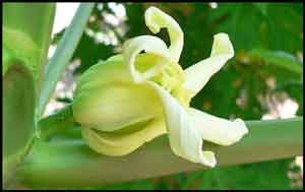 |
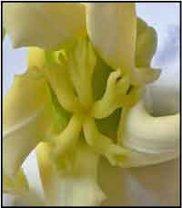 |
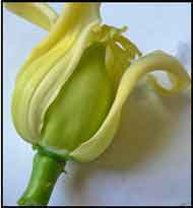 |
| Left:
Pistillate inflorescence; Centre: Pistillate stigmatic
rays; Right:
Pistillate petal insertion. |
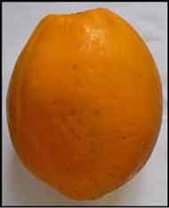 |
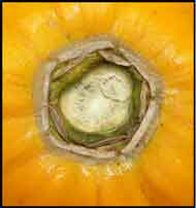 |
Left:
Pistillate fruit, smooth ovoid. Right: Pistillate scars
surrounding the stem end of the fruit. Sepals are not
prominent
in
pawpaws but here the 5 separate
outer and alternately-placed
scars from
them can
also be seen. |
| 3.
Flower morphology – interior |
|
|
|
|
| Gently peel off the petals one at a time
as needed. You might find a
hand lens helps you see some of the following details. |
|
|
|
| a.
|
Staminate. The 10 stamens can
now be seen more clearly in 2 separate
alternating whorls of 5, with one series being sub-sessile
anti-petalous and the other anti-sepalous on short filaments. There is
only a rudimentary and non-functional central pistil (pistillode). |
| b. |
Pistillate. There are no
stamens. The 5-carpellate pistil is usually
smoothly circular or slightly undulate, and the apical stag-like stigma
is now clearly visible.
|
| c. |
Hermaphrodite types. |
|
|
|
|
i.
|
Elongata. This
is the preferred type of hermaphrodite. There are 10
stamens at the throat of the corolla tube. The stamens are arranged
similarly to staminate flowers. In some plants the anthers and stigmas
are at the same level and in others different, with consequent effects
on ease of pollination. The pistil is 5-capellate but can vary from
1-10. |
|
ii.
|
Pentandria.
So-called because it has 5 fairly short anti-sepalous
stamens. These are fused to both the pistil and the petals at the base,
which is just below the throat of the short corolla tube. The pistil is
5-carpellate and deeply furrowed with the stamens lying along these
grooves. |
|
iii. |
Carpelloid
forms. Carpellody is where stamens lose their pollen
forming ability and become carpel-like by fusing with the pistil. There
is great variation in these forms. Petals may be almost free from one
another or fused with others for up to 70% of their length, even within
a single flower. There may be 2-10 stamens in different stages of
transition from anthers to carpels, and their fusion with petals and
pistil can also vary. Pistils are often distorted with 5-10 carpels.
Sometimes there may be faulty fusion leaving ovules exposed and in
others the original 5 carpels may abort. Many of these unsatisfactory
variants are driven not only by the genetic make-up of the plant but by
unfavourable cultural and environmental factors. |
4. Fruit
You can firm up your diagnosis when the plant begins to fruit.
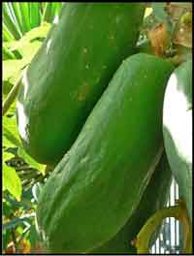 |
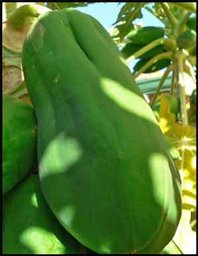 |
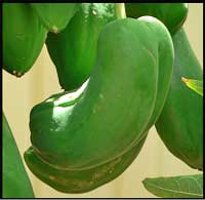 |
| Left
to right: Elongata fruit; Pentandria fruit; Carpelloid pentandria fruit. |
| a. |
Pistillate. Globose-obovoid
without furrowing. Surrounding the stem at
the base of the fruit, there are 5 separate scars where the 5
individual petals have abscised. This type is the least subject to
cultural and environmental influences. |
| b. |
Hermaphrodites. |
|
|
|
|
i. |
Elongata. The
best fruit of the 3 hermaphrodite types. The most
common form is 5-carpellate and pyriform or cylindrical. Flowers with
only a few carpels form narrow fruits similar to bananas. |
|
ii. |
Pentandria.
Sightly oblong-cylindrical with 5 longitudinal furrows.
The fruit stem end shows a continuous circular scar which comes from
the remnants of the abscised corolla tube. |
|
iii. |
Carpelloid
forms. Carpelloid forms. The least satisfactory of the 3 basic
hermaphrodite types. They are usually misshapen, sometimes grotesquely,
and are not commercially marketable. When you cut the fruit you will
sometimes see more than a single, central seed cavity. Even for the
home grower it’s probably not worth keeping the tree. |
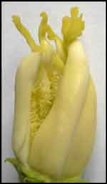 |
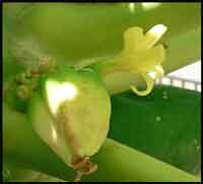 |
Left:
Male and recently-fertilized carpelloid pentandria
flowers in
a single cyme; Right: Carpelloid pentandria
flower de-petalled
showing incomplete fusion and
exposed ovules. |
Sex-reversing
males
With adverse cultural and environmental conditions (eg temperatures
below 12°C through our winters) these trees which normally produce male
flowers can become hermaphrodite. Incidentally, although commonly used
in the literature, the term ‘sex-reversal’ is somewhat misleading. True
reversal would take male through to female, but in these plants their
gender change only goes half-way, having both male and female organs
The flowers are larger and more bulbous than pure male types. They
usually occur terminally on the peduncle and have an elongated pistil
with a variable number of surrounding stamens. The fruit are narrow,
elongated, furrowed and sometimes quite distorted. Certainly not
commercially marketable and even for the home grower, not worth
producing. If you decide to keep the tree, at least remove the fruit to
prevent waste of plant resources.
Left:
Normal inflorescence in a sex-reversing male; Centre: Sex-reversed
hermaphrodite de-petalled flower
showing elongata-like
features with a substantial fused corolla tube length and stamen
insertion
at the corolla throat; Right: Elongated sex-reversed
male fruit showing deep pentandria-like furrows. |
Back to
Papaya Page
|













